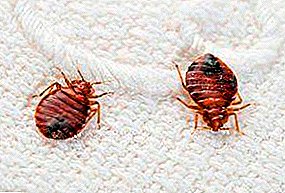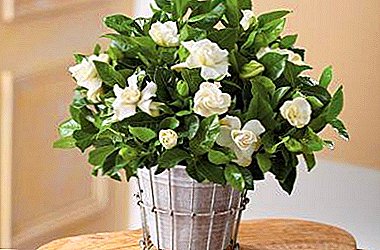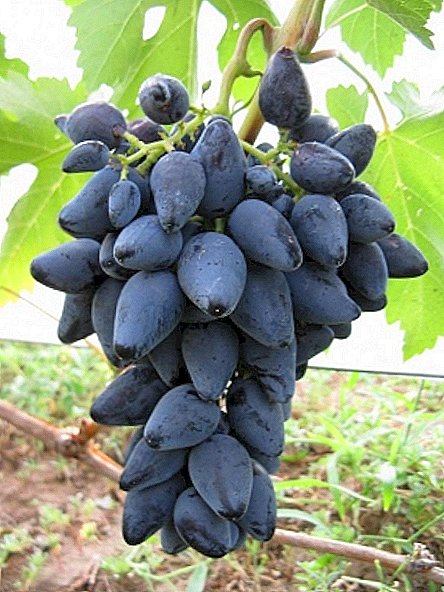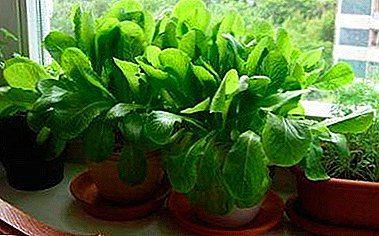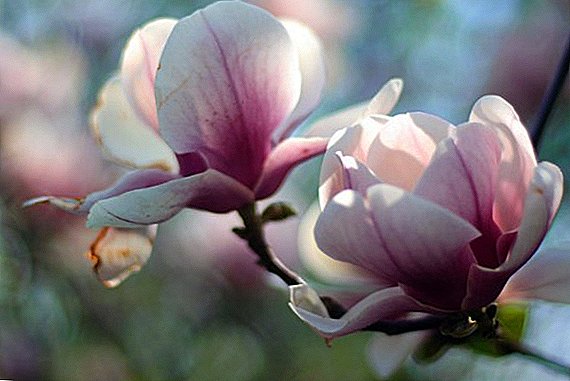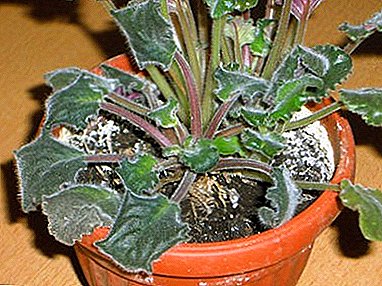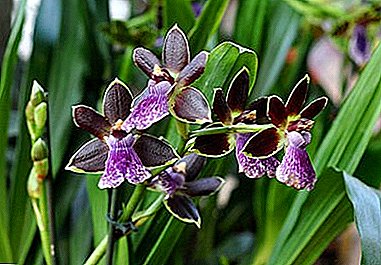
Orchid Zygopetalum is an unpretentious and highly decorative flower. Differs in motley blotch of bright colorful flowering.
Quite a small genus zygopetalum (Zygopetalum) is directly related to the orchid family. It combines 15 different species. This genus is represented by epiphytes, but sometimes in certain habitat conditions they can become lithophytes or land plants. All species of this genus can be found in the tropical regions of America, but the largest populations are found in the rain forests of Brazil.
Brief Definition
Zygopetalum (Zygopetalum) - the flower belongs to the ancient genus Orchids. It is considered a monocotyledonous perennial epiphyte and lithophyte, also belongs to the terrestrial plants. The birthplace of the flower is Mexico, Brazil, Peru, tropical areas of South America. Natural habitat - rock gorges, tropical rain forests, rocky areas.
Botanical description
 Stem creeping, growing ladder. High shoots, grow to 50 - 60 cm in height. Pseudobulbs are short, up to 6 cm in length, oval, smooth. Have a bright green color. The structure is slightly compacted. Pseudobulbs are located in a nest of lower leaves, later dying off.
Stem creeping, growing ladder. High shoots, grow to 50 - 60 cm in height. Pseudobulbs are short, up to 6 cm in length, oval, smooth. Have a bright green color. The structure is slightly compacted. Pseudobulbs are located in a nest of lower leaves, later dying off.
The leaves are shiny, pointed, wide, leathery, glossy. There are subsorts with lanceolate leaves. Sheet plate has longitudinal ribs. Peduncle straight, up to 45 - 50 cm long, grows from the lower leaves. Inflorescences of the plant - racemes that form up to 12 budsgrowing consistently. The flowers themselves are variegated, spotty. Have a different color of green, purple, white hue. There are plain colors of petals. Lip contrast stands out - large, bright purple or lilac.
Large flowers are fragrant. The root is dense, fragile. The processes are white, thick, spiraling.
History of
Zygopetalum Orchid - from Greek - "paired", "yoke" and "petal". Natural varieties are considered to be South American orchid varieties. The genus is small, there are up to 15 species. The cultivated varieties in modern floriculture are widespread throughout Europe. The view is easy to maintain, unpretentious, requires conditions close to the natural conditions of the tropics.
What is the difference from other species?
The orchid Zygopetalum differs in unusual growth of stalks, belongs to sympodial type. Creeping rhizome grows in steps - each new part rises above the base of the old pseudobulb. This variety has an unusual structure of the flower itself, pointed petals grow together at the base of the central column.
Variety, unlike other orchids, does not tolerate alternate "drying" of the substrate.
Root shoots do not have a protective layer that is able to retain moisture in the substrate.
Podort and their photos
It should be noted that hybrid varieties are adaptable to housing conditions.
The most popular subsort.
Maculatum

The variety has large flowers with a diameter of up to 7 cm. The inflorescence combines up to 10 - 12 flowers. Peduncle long, straight, up to 45 cm. Petals variegated, green with brown spots. The lip is white, striated with light purple stripes.
Amazonica

The flowers are white, the lip is marked with purple stripes. The leaves grow like a fan, light green, lanceolate. Up to 20 cm in length. The orchid has a persistent scent of flowers.
Lindeniae

The flowers of the plant are variegated, star-shaped in shape.. Flower diameter up to 7 - 8 cm. Flowers are light green with brown stripes. Lip contrast, white color with bright purple stripes. The leaves are bright green, pointed, shiny, up to 25 - 30 cm in length.
Bloom
When and how is it going?
This variety can bloom at any time of the year with additional stimulation.
Features care at home before and after
Tsvetokon at Zygopetalum grows when not formed pseudobulba. During flowering sprouts stop growing. Stems begin to grow after flowering.
To extend flowering orchid should be rearranged in a half-shaded place.
During the rest period, when the pseudobulbs have matured, the air temperature should be reduced to 18 - 20 ° C. The required air humidity is 60 - 70%. Watering is reduced.
What to do if not dissolved?
With improper care, the peduncle may not grow. Additional stimulation of the flower is needed. It is necessary to reduce watering, reduce air temperature by 3 - 4 ° C.
Care instructions at home
Choosing a place
The orchid zygopetalum grows well only in partial shade. The pots are better placed on the western or eastern windowsill. Southern windows require shading with a light curtain, especially at lunchtime. The northern location requires additional lighting with special lamps for 4 hours a day.
Soil preparation
 Substrate for this variety requires loose, wet, drained.
Substrate for this variety requires loose, wet, drained.
The composition of the drainage must include pieces of bark and expanded clay, crumb foam. To preserve moisture in the soil add perlite. Vermiculite is added to maintain substrate looseness..
Soil composition:
- Moss - sphagnum - 1 h.
- Sodland - 1 hour
- Peat - 1 hour
- Dry leaves - 1 hour
- Drainage.
Pots
For beginner gardeners, it is better to use plastic transparent pots to monitor the condition of the roots and the integrity of the soil.
For good breathability, it is recommended to make drainage holes not only at the bottom of the pot, but also along the entire side surface of the container. Also used wooden boxes, rack baskets.
Temperature
Temperature regime for orchid zygopetalum requires moderate. Summer air temperature is 24 - 25 ° C during the day and up to 18 - 19 ° C at night. In the autumn-winter period, it is necessary to reduce the temperature to 18 - 21 ° C during the day, at night to 16 ° C.
For normal development, a daily temperature difference of 3 to 4 degrees should be observed.
When the spring heat is established, the pots can be taken out to fresh air - to open verandas and loggias. The climate of medium latitude allows the plant to receive a natural temperature difference at night and during the day.
Humidity
 The required air humidity is up to 70 - 90%. The permissible framework for zygopetalum is 60%. In the heat, you should spray the flower, wipe the leaves with a damp cloth. Also near the pots are placed open containers with water. You can set the pots on a wet layer of expanded clay.
The required air humidity is up to 70 - 90%. The permissible framework for zygopetalum is 60%. In the heat, you should spray the flower, wipe the leaves with a damp cloth. Also near the pots are placed open containers with water. You can set the pots on a wet layer of expanded clay.
In greenhouse conditions, special steam generators that artificially moisturize the air are used to increase the humidity.
Lighting
Orchid zygopetalum prefers bright but diffused light. Bright direct rays are contraindicated flower. Leaves - indicator of the resulting lighting. If spots appear on the leaves, shade the windows, remove the pots further from the windows. If the leaves are dark - light is added.
Watering
This variety loves moisture. In summer, watering is abundant, regular. Required morning spraying. It is recommended to arrange a warm shower twice a month..
When watering water should not fall on the inflorescences themselves. Flowers lose their appeal. In winter, watering is reduced. The substrate should not dry out, but the dampness of the substrate should not be allowed.
After the shower of the sinus leaf, the outlet must be wiped with a cotton swab.
Water for irrigation should be used only separated, purified. You can use rainwater. It is recommended to use watering by immersion. The pot is placed in a large container with water for 15 to 20 minutes. Water after the procedure should drain completely, it is drained from the pan.
Top dressing
 View requires frequent, but dosed dressings. Potassium and phosphate fertilizers are commonly used. You can use liquid fertilizer specifically for orchids. For an even distribution of mineral fertilizers, top dressing is combined with irrigation..
View requires frequent, but dosed dressings. Potassium and phosphate fertilizers are commonly used. You can use liquid fertilizer specifically for orchids. For an even distribution of mineral fertilizers, top dressing is combined with irrigation..
During the period of active growth, nitrogen fertilizers are used to build green mass.
In the summer they fertilize flowers 2 p. in Week. In winter, it is enough to fertilize the substrate once a month.
Transfer
Replant the plant should be every 2 -3 years, when the roots have grown too much, the pot has become small. A transplant is also necessary if the substrate is decomposed or contaminated with a pathogenic infection. The procedure is carried out in the spring, before the formation of buds.
Transplant plan:
- Well moistened soil in a pot.
- Carefully removed the flower.
- Clears the root of the old soil.
- Old, dry, damaged root processes are cut.
- Dried stems are also removed.
- Slices are treated with disinfectants, charcoal.
We offer you to watch a video on how the Zigopetalum orchid transplant is performed:
Breeding
Zygopetalum is the most acceptable way of breeding orchids.. Each separated part should have 2 to 3 healthy pseudobulbs.
Scheme of rhizome division:
- The roots are cleaned from the old substrate, rotten and dry roots are cut off.
- The flower is divided into several parts.
- The separated parts are sprinkled with crushed coal, dried in the open air.
- Seedlings are immersed in moss - sphagnum in special containers for maturation.
- Watering is regular before rooting.
Diseases and pests
 The most common pests of orchids Zygopetalum:
The most common pests of orchids Zygopetalum:
- A warm shower will help get rid of the spider mite. You can process the leaves of phytotherm. The treatment should be repeated 2 - 3 times with an interval of 10 - 12 days.
- Snails and slugs usually attack the leaves of a flower, leaving silvery-white traces. Used drug mezurol.
- From stagnation of water and excessive moisture, root and gray rot of stems appears. Requires transplantation, replacement of the substrate, treatment with a fungicide.
For the prevention of rot, scarab, fungi, it is recommended to wipe the leaves with a weak solution of coniferous extract: for 1 l. water 20 g of funds.
For good flowering, growth and development of orchid zygopetalum is required to comply with the necessary rules of care: regular watering, timely transplant, dosed top dressing and prevention of diseases and pests.


